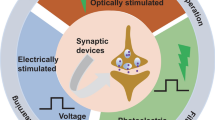Abstract
Neuromodulation is the alteration of neuronal and synaptic properties in the context of neuronal circuits. It allows anatomically defined circuits to produce multiple outputs reconfiguring networks into different functional circuits. In this work, neuromodulation is mimicked using a solution of two direct photochromic compounds, a naphthopyran and a spirooxazine, which are models of phasic excitable neurons, sensitive to UV radiation. When the system, constituted by the two photochromic compounds, receives a UV signal, it behaves as a recurrent network with mutual inhibitory actions. The network responds to different UV wavelengths by changing its photo-excitability, synaptic strength, wiring of the circuit, and dynamics. These results contribute to the development of neuromorphic engineering. They will promote the design of artificial neural networks with a larger number of nodes, communicating through optical signals. These networks will be the essential ingredients of the new-generation brain-like computing machines complementing current electronic computers.









Similar content being viewed by others
References
Aquilanti V, Borges EP, Coutinho ND, Mudim KC, Carvalho-Silva VH (2018) From statistical thermodynamics to molecular kinetics: the change, the chance and the choice. Rend Fis Acc Lincei 29:787–802
Aquilanti V, Coutinho ND, Carvalho-Silva VH (2017) Kinetics of low-temperature transitions and a reaction rate theory from nonequilibrium distributions. Philos Trans Roy Soc A Math Phys Eng Sci 375(2092):20160201
Gentili PL (2013) Small steps towards the development of chemical artificial intelligent systems. RSC Adv 3:25523–25549
Gentili PL (2014) The fuzziness of a chromogenic spirooxazine. Dyes Pigments 110:235–248
Gentili PL (2018a) The fuzziness of the molecular world and its perspectives. Molecules 23:2074
Gentili PL (2018b) Untangling complex systems: a grand challenge for science. Taylor and Francis Inc. (CRC Press), Boca Raton
Gentili PL, Romani A, Becker RS, Favaro G (2005) The photoinduced ring opening reaction of benzo(2H)chromenes: a kinetic and thermodynamic approach. Chem Phys 309:167–175
Gentili PL, Horvath V, Vanag VK, Epstein IR (2012) Belousov-Zhabotinsky “chemical neuron” as a binary and fuzzy logic processor. Int J Unconv Comput 8:177–192
Gentili PL, Dolnik M, Epstein IR (2014) “Photochemical oscillator”: colored hydrodynamic oscillations and waves in a photochromic system. J Phys Chem C 118:598–608
Gentili PL, Rightler AL, Heron BM, Gabbutt CD (2016a) Extending human perception of electromagnetic radiation to the UV region through biologically inspired photochromic fuzzy logic (BIPFUL) systems. Chem Commun 52:1474–1477
Gentili PL, Rightler AL, Heron BM, Gabbutt CD (2016b) Discriminating between the UV-A, UV-B and UV-C regions by novel biologically inspired photochromic fuzzy logic (BIPFUL) systems: a detailed comparative study. Dyes Pigments 135:169–176
Gentili PL, Giubila MS, Germani R, Romani A, Nicoziani A, Spalletti A, Heron BM (2017) Optical communication among oscillatory reactions and photo-excitable systems: UV and visible radiation can synchronize artificial neuron models. Angew Chem Int Ed 56:7535–7540
Gentili PL, Giubila MS, Germani R, Heron BM (2018) Photochromic and luminescent compounds as artificial neuron models. Dyes Pigments 156:149–159
Hayashi K, Gotoda H, Gentili PL (2016) Probing and exploiting the chaotic dynamics of a hydrodynamic photochemical oscillator to implement all the basic binary logic functions. Chaos 26:053102
Horvath V, Gentili PL, Vanag VK, Epstein IR (2012) Pulse-coupled chemical oscillators with time delay. Angew Chem Int Ed 51:6878–6881
Izhikevich M (2007) Dynamical systems in neuroscience. MIT Press, Cambridge
Katz PS, Calin-Jageman RJ (2009) Neuromodulation. In: Squire LR (ed) Encyclopedia of neuroscience. Elsevier Ltd, Netherlands, pp 497–503
Korn H, Faure P (2003) Is there chaos in the brain? II. Experimental evidence and related models. C. R. Biol 326:787–840
Lee Y, Lee T-W (2019) Organic synapses for neuromorphic electronics: from brain-inspired computing to sensorimotor nervetronics. Acc Chem Res 52:964–974
Machado HG, Sanches-Neto FO, Coutinho ND, Mundim KC, Palazzetti F, Carvalho-Silva VH (2019) “Transitivity”: a code for computing kinetic and related parameters in chemical transformations and transport phenomena. Molecules 24(19):3478
Mead C (1990) Neuromorphic electronic systems. Proc IEEE 78:1629–1636
Nandakumar SR, Kulkarni SR, Babu AV, Rajendran B (2018) Building brain-inspired computing systems. IEEE Nanotech Mag 12:19–35
Nawrocki RA, Voyles RM (2016) A mini review of neuromorphic architectures and implementations. IEEE T Electron Dev 63:3819–3829
Rabinovich MI, Varona P, Selverston AI, Abarbanel HDI (2006) Dynamical principles in neuroscience. Rev Mod Phys 78:1213–1265
Ramirez J-M, Tryba AK, Peña F (2004) Pacemaker neurons and neuronal networks: an integrative view. Curr Opin Neurobiol 14:665–674
Rinzel J, Huguet G (2013) Nonlinear dynamics of neuronal excitability, oscillations, and coincidence detection. Commun Pur Appl Math LXVI:1464–1494
Russell SJ, Norvig P (2009) Artificial intelligence: a modern approach. Prentice-Hall, New Jersey
Yilmaz E, Ozer M, Baysal V, Perc M (2016) Autapse-induced multiple coherence resonance in single neurons and neuronal networks. Sci Rep 6:30914
Author information
Authors and Affiliations
Corresponding author
Ethics declarations
Conflict of interest
The authors declare that they have no conflict of interest.
Additional information
Publisher's Note
Springer Nature remains neutral with regard to jurisdictional claims in published maps and institutional affiliations.
This paper belongs to a Topical Collection originated from presentations at the Conference Statistical thermodynamics and chemical kinetics: far away from equilibrium held at the Accademia Nazionale dei Lincei in Rome, 25–26 June 2019. under the auspices of the Foundation Guido Donegani. Program and abstracts at the link https://www.lincei.it/it/manifestazioni/statistical-thermodynamics-and-chemical-manifestazione.
Rights and permissions
About this article
Cite this article
Bartolomei, B., Heron, B.M. & Gentili, P.L. A contribution to neuromorphic engineering: neuromodulation implemented through photochromic compounds maintained out of equilibrium by UV–visible radiation. Rend. Fis. Acc. Lincei 31, 39–52 (2020). https://doi.org/10.1007/s12210-020-00869-y
Received:
Accepted:
Published:
Issue Date:
DOI: https://doi.org/10.1007/s12210-020-00869-y




